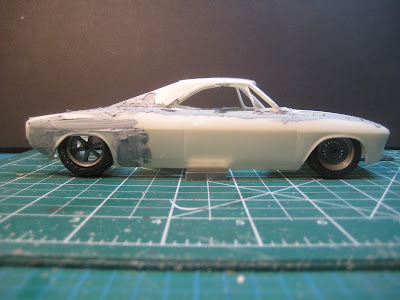I've always liked the shape of the last Corvair, but was less enthused about the rear-mounted air-cooled six. The Germans did that layout way better.
I've also seen 1:1 cars and models of Corvairs converted to V8 power,
either rear-engined (talk about unsafe at any speed!) or converted to
mid-engined layout.
Separately I have had this LS3 V12 engine and
transaxle (3D printed by Ron Olsen at Shapeways) lying around for some time. This is
essentially a 6-litre small-block Chevy, with 4 more cylinders tacked on, and apparently models an actual real engine. So what would be a better place for a mid-engined 9-litre small-block Chevy than
in the back seat of a Corvair? I knew you would agree with me.
One issue of course will be fender flares, and a quick trip through the boneyard unearthed remnants of a couple of previously hacked-up 935s (see my 956 pickup, here). A better but more challenging plan will be to pull the Corvair fenders out. Either way maintaining some structural integrity of the body will be key to success. (I also have some 956 chassis bits left over from the 956 pickup, such as rear A-arms, hubs and driveshafts.)
Some planning reveals that I will likely need to alter the wheelbase, probably by moving the rear axle rearwards. Some initial layout suggests that moving it back 1/2" would allow reuse of the Corvair fenders, but will stillrequire moving the cockpit forward. Extending the wheelbase a full inch (which would be 24" at full scale) requires using the 935 or new fabricated rear fenders. Being a reasonable fellow, I think I'll go for the less extreme option.
The cockpit, along with the windshield and dashboard, may need to be moved forward a bit with some minor intrusion of the front wheel wells into the footwell. This opens up all kinds of opportunities for a shortened and lowered roof... so stay tuned while I verify the stash of spare #11 blades and fine razor-tooth saws.
Dr Tom is wanted in Surgery! Hacking and slashing is in the forecast!










































